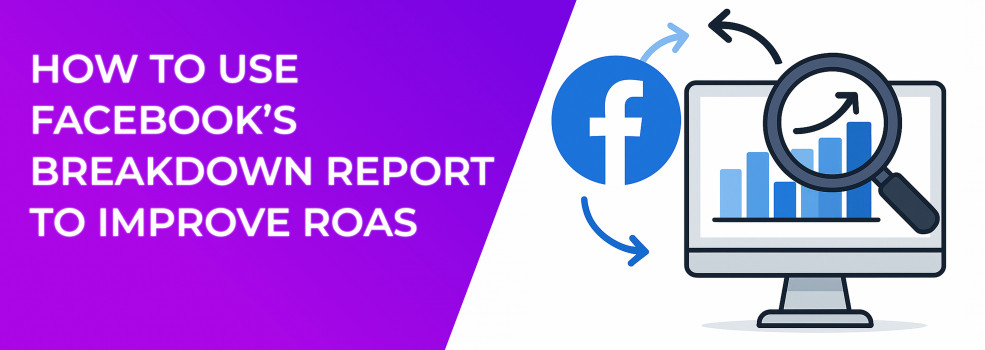When you stare at the all-campaign totals in Ads Manager, it is easy to believe everything is humming along smoothly. The illusion shatters the moment your boss asks why return on ad spend (ROAS) slipped from 4.1 to 2.9 overnight. Facebook’s (now Meta’s) Breakdown Report gives you the power to see exactly where profit leaked and how to plug the hole. In the guide below you will find practical, jargon-free tactics, seasoned with real-world Facebook ad optimization experience, that can boost performance for any brand or agency.
1. What the Breakdown Report Actually Is
Before you start slicing and dicing, be clear on what Breakdown really does. It is a magnifying glass inside Facebook ads reporting that lets you split campaign performance by countless dimensions and detect
Tables offer a quick visual snapshot. Use this one as a launchpad, then explore your own campaigns in Ads Manager.
2. Why Breakdown Works Like a ROAS Radar
Think of Breakdown as early-warning radar for every performance wobble your campaigns might experience. It helps you:
-
Pinpoint wasted spend quickly. You might discover that 30 percent of your budget flows to 18–24-year-olds on Audience Network at a five-dollar average cost per click Facebook, twice your profitable threshold.
If you keep bumping into the dreaded “Ad Set May Get Zero” message, this step-by-step fix will help your ads start serving again. -
Find hidden champions. One creative and placement pairing could deliver a nine-percent average click-through rate on Facebook ads yet receive only five percent of budget.
-
Improve creative with data. High ad impressions Facebook but low CTR? Swap the thumbnail or lead-in hook.
-
Build stakeholder trust. A clear ads analysis of winners and losers is far stronger than “we are still optimizing.”
Detection is only the first step. Commit to immediate action once you know where leaks occur.
3. Key Metrics to Track Inside Breakdown
A metric is only useful if it drives a decision. Focus on the following:
-
Impressions and Reach to confirm that each slice has enough data.
-
CTR and CPC to gauge efficiency; a lagging Facebook ads stats row often predicts poor ROAS.
-
Cost per Result and Conversion Rate to sanity-check your funnel.
-
Purchase ROAS as the single source of truth for e-commerce.
Unsure which objective best matches your profit goals? Check our primer on Meta ad campaign objectives before you pull the next report. -
Value per Impression (custom metric) for high-volume prospecting campaigns.
Revisit these numbers after every change. Improvement is the only proof that an optimization mattered.
4. Step-by-Step: Pulling Your First Breakdown Report
Ready to get rolling? Follow these steps and you will have actionable insights in minutes.
-
Open Ads Manager and select Reports, then Create.
-
Choose the campaign, ad set, or ad you want to dissect.
-
Click Breakdown and pick a dimension such as Placement and Device.
-
Add columns like ROAS, Cost per Purchase, and your key Pixel Facebook Ad events (Purchase, Add to Cart, ViewContent).
-
Save the view or export to Sheets for deeper analysis.
Repeat this process weekly. Regular cadence prevents costly surprises.
Quickly generate actionable insights by using Facebook’s Breakdown report to segment performance data.
Pro tip: If you use Advantage Campaign Budget or any campaign budget optimization strategy, start by pulling Breakdown at the ad-set level. It shows where the algorithm is over- or under-feeding.
5. Turning Insights into Action
Finding the problem is only half the battle. The real magic happens when you act on the data. Here are five high-impact moves.
5.1 Reallocate Budget
Shift spend from rows with ROAS below target to those above it. The best-performing slice often signals the best way to optimize Facebook ads, for example scaling Instagram Reels while capping Audience Network.
5.2 Refine Audiences
If 45–54-year-olds dominate purchases, spin up a dedicated ad set and craft creative that speaks directly to them. This avoids the learning-limited reset that broad edits cause.
For a fundamentals refresher, dive into Facebook Ad Targeting 101 before you rebuild those high-value segments.
5.3 Tighten Placements
Stories might deliver high CTR but low conversion. Test vertical video with a clearer call-to-action. If Feed accounts for 80 percent of revenue, duplicate the ad set as “Feed only” and push budget until marginal CPC climbs.
If rising costs are really ad fatigue in disguise, learn how to spot and fix Facebook ad fatigue fast.
5.4 Adjust Bidding and Budget Caps
Inside a weak slice, tighten bid caps or set a cost-per-result guardrail. Meanwhile, raise caps where ROI for Facebook ads is strongest.
5.5 Refresh Creative Quickly
Breakdown by Creative and Placement to see which thumbnail or headline drags performance. Swap just that asset, preserve social proof, and avoid full resets.
After each optimization step, note the change in ROAS. This habit builds a personal library of tactics that reliably work.
Feeling stuck for fresh concepts? Browse the ultimate guide to Facebook ad formats to spark new creative angles.
6. Advanced Moves to Level Up
Once you master the basics it is time to add nuance. The tactics below unlock deeper efficiency gains.
Platform-wide changes roll out every quarter — see the latest Facebook ads targeting updates for 2025 so your Breakdown insights stay current.
Experiment with one tactic at a time so you can trace performance lifts back to specific changes.
7. Measuring the Lift
Optimization is incomplete without a clear read on results. Use this simple three-step process to confirm progress.
-
Pull the same Breakdown for the previous seven-day baseline.
-
Apply your optimizations and allow at least seventy-two hours for the algorithm to restabilize.
-
Re-run the report and look for a 10–15 percent lift in ROAS or a 20 percent drop in cost per result on targeted slices.
If ROAS still lags after tweaks, this checklist on why Facebook ads are not converting will uncover hidden issues.
If targets are not met, iterate again, documenting what you changed and why.
8. Final Thoughts
The Breakdown Report is more than a diagnostic screen; it is the steering wheel for sharper Facebook ad performance. Instead of guessing why a campaign faltered, you now know who, where, and why within minutes. Pair these insights with the rest of your toolkit, including campaign budget optimization, server-side events, and dynamic creative, and watch ROAS rise while wasted spend shrinks.
Start breaking things down today. Your budget and your boss will appreciate the results.

